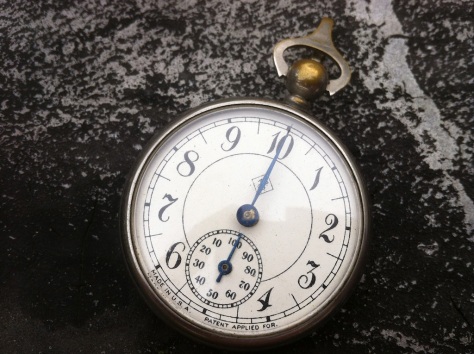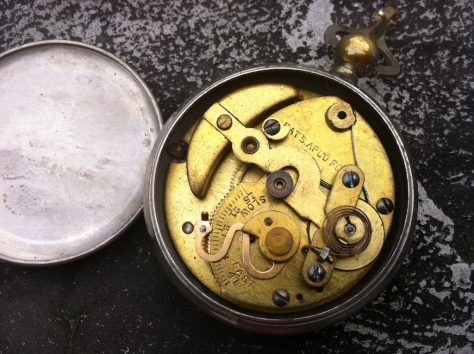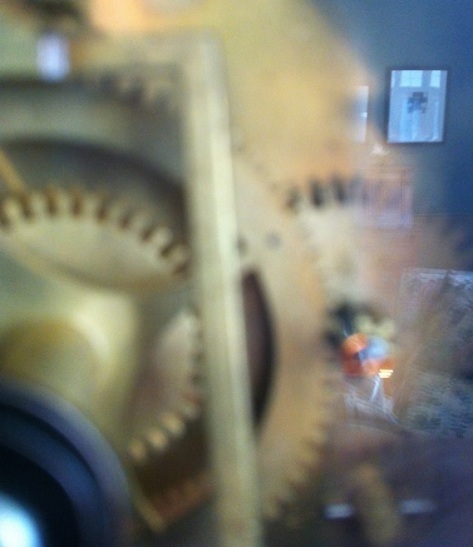
American Pedometer Company dual-dial mechanical analog pedometer, circa 1903 (obverse/face side)

American Pedometer Company dual-dial mechanical analog pedometer, circa 1903 (reverse/back side)…
And so begins an occasional series of steampunk style inspirational items, one at a time, as they steam into our goggle’s field of vision. They’ll be filed under the category of “Objective Inspiration”, in the navigation menu, for your further perusal (we’re helpful like that).
This is a pretty little device I picked up last weekend at a tag sale (the Vermont version of a yard or garage sale) at the Putney Public Library, whilst returning from the 25th celebration of The Grammar School’s Medieval Faire. It is a mechanical (self-winding) analog pedometer, dating from the turn of the century (need I say which?). This wonderful find was built by the American Pedometer Company, in New Haven, Connecticut. Their simple diamond-shaped logo, with “AP CO” inside, is at the top center of the dial; along the very bottom of the paper dial are the legends “MADE IN U.S.A.” and “PATENT APPLIED FOR.” Other model pedometers of a similar vintage labelled simply “American Pedometer” were made by the New Haven Clock Company, along with their eponymous “New Haven Pedometer.” The brass works of some of these other NHCC models are identical to those of my example, so perhaps the two companies merged, or were divisions of one another, at some point. The American Pedometer Company info page referenced above (from the amazing collection of mathematical instruments assembled by David M. Riches , a British Mechanical Engineer – Levi Fuller would be proud) amply demonstrates this fact.
From my research thus far, it has the features of the version patented in March 1902 and September 1903 (US Patents 694,652 and 738,482) with a W-shaped spring maintaining tension (see bottom of obverse photo) on the Stride Adjustment innovation. This handy feature allowed the user to calibrate the device to one’s individual stride length, from 15 to 41 inches. The interior works are all brass; the case is brass plated in an unknown metal (silver or chrome?) – note the worn knob to which the belt hook is attached. The instrument was clipped on to the wearer’s’s belt, probably through an unused buckle hole, and the action of walking would cause the centrifugal weight inside the case to swing, and actuate a click-over of the gears, advancing the hand(s) on the dial(s). The double dials measured a total of 100 miles: once around the large dial clockwise was 10 miles and once around the smaller, lower dial counter-clockwise (or perhaps anti-clockwise, as Mr. Riches might say) would add to 100 miles in increments of 10. The pedometer could be reset by turning the small knurled knob in the center of the back works. It seems a bit vulnerable to require popping the back off repeatedly and jabbing at the tiny dial but that’s how the task was performed.
I was delighted to pick this beauty up for only $5 (the seller just happened to be a talented painter who is a friend of mine, but I paid full tag sale price nonetheless); looking it up online, I can find it being sold for around $20-$35. Some of the extant examples are in quite poor shape; I was lucky enough to acquire this one in very good condition. I also turned up a nice photo and steampunk friendly description by Don Simpson on DeviantArt of the identical model which is in my sweaty little hands…


